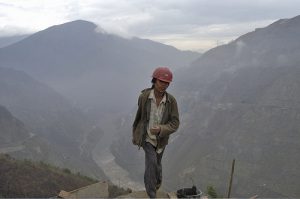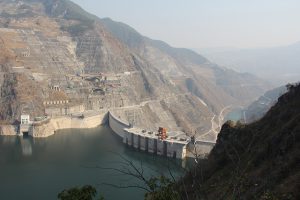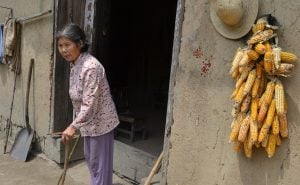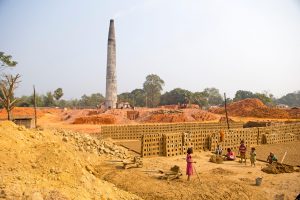This is the first in a two-part special report on the resettlement rights of villagers displaced by dams along the Mekong River. Part one, below, is an analysis of how China’s resettlement policies are playing out on the ground. Part two is an insight into the experience of one village Xiaohe on the upper Mekong.
After decades of controversy over resettlement, China now plans to double its hydropower capacity by 2030, mainly by building dams on the Mekong and other rivers in southwest China.
From far away Kang Lianghong and his wife look like little white dots, zig-zagging their way down the steep hillside. Move closer and you can see they are carrying bags of fertiliser under one arm, using their other hand to throw handful after handful onto the earth.
Kang wasn’t very good at doing this when they were moved here 13 years ago, from the flat of a river valley. In the winter of 2000 he and his wife, along with almost 4,000 people from eight villages, were resettled to the town of Aihua to make way for the Dachaoshan dam. The dam was built on the Lancang river (known as the Mekong outside China), downstream from Manwan, the first dam to be built on the river.
But there are now shortages of water for irrigation and drinking in Aihua. Yunnan is in the middle of the worst drought for a century. The resettled people are wondering why over 20 million yuan (US$3.3 million) was spent on irrigation schemes that are now useless.
Dried-up irrigation
In one corn field production team head Li Shilong points out a pipe and channel: “They dug that before we moved here, the resettlement bureau said it cost 6.47 million yuan (US$1 million). The water for irrigation was piped in from Fengqing, at a cost of 100,000 yuan (US$16,400) a year.” But two years later the bureau stopped paying for the water.
When questioned, a bureau official who was unwilling to give his name explained the plan was to reduce water by planting corn or commercial forests rather than rice. But as Li and the other villages point out, they’re already planting corn, and there still isn’t enough water.
Four resettlement areas – Ganlangqing, Wayaoba, Hongdouqing and Huiyingba – suffer similar problems. These are steep hillsides, and once the forests are felled nothing protects the sandy soil from erosion. And the soil is poor and dry, meaning harvests are small. Paddy fields were all drained some years ago. Yields on Li’s land have fallen by half and he is spending an extra 800 yuan (US$130) a year on fertiliser. “In another ten years I won’t even be able to plant corn, but in the valley we used to live in you could eat for two years off one harvest.”
There is also a shortage of drinking water. Yang Wenwei says that 90% of the villagers are suffering from kidney stones. Three years ago he had to be rushed to hospital by ambulance due to the pain. Kang Lianghong says the pain from his kidney stones was so bad he kicked the bed to pieces.
No option but protest?
Apart from the one month a year he is busy farming, Li is a “professional petitioner”. Since moving to Ganlanqing he has made several trips a year to the county seat to try and get the land, water, roads and compensation which he was promised. He is accompanied by anywhere between a dozen and a thousand people each time. Over this period the resettlement bureau has had eight different heads, while there have been four different deputy county heads in charge of resettlement issues.
If you become a habitual petitioner, you can get results. Once when walking into the resettlement bureau Li saw a member of staff hiding a document in a drawer. Grabbing it, he saw that the resettled villagers should have got 435 yuan (US$70) for new farmland, not the 235 yuan (US$38) they were actually given. The official claimed this was a mistake and handed out the extra money.
Li recalls one time in 2003, when almost one thousand villagers spent three days protesting outside the bureau. Thirty-three people were arrested after things got out of hand and roads were blocked.
Dachaoshan is one of fifteen dams planned on the Lancang river in Yunnan, which in total will generate 25.605 gigawatts of electricity, according to the Sinohydro website. So far four dams have been built and are in operation, while dams at Nuozhadu and Gongguoqiao have been given approval.
According to Liu Zhi, a researcher at the Transition Institute in Beijing, “the current regulations on resettlement mean that people relocated by dams are often only able to resolve issues via protests.” The current regulations say the opinions of those already living in the areas they are being moved to “should” be listened to, and “when necessary” hearings should be held. That type of language allows project operators and local governments to ignore legitimate requests for compensation.
Rights are more important than compensation
But Liu has seen some progress from the government. In 2006 China introduced less coercive regulations on resettlement and land requisition for dam projects. In 2012, the National Development and Reform Commission ordered that resettlement should take place before construction starts, to improve the resettlement process and protect their rights and to ensure the projects go ahead smoothly.
Standards for compensation are also improving. “Compensation for resettlement is ten times what it used to be,” says Yu Xiaogang, head of Yunnan-based NGO Green Watershed, quoting provincial government figures. When the Manwan dam was built in the 1980s, the average compensation was 8,000 yuan (US$1,313). Today it is 80,000 yuan (US$13,130).
But there is a difference between compensation and rights, argues Yu Xiaogang. “Although policy has progressed and compensation is higher, there’s been no improvement on ensuring the rights of relocatees, and in some locations infringement of rights is grave.”
Yu has visited people displaced by the Dachaoshan dam four or five times. He gave those books to Li Shilong. 90% of people resettled by dams are rural residents who tend to have less awareness of their rights.
Yu says that “the people often don’t know what rights they have. In 2007 China signed the UN Declaration on the Rights of Indigenous Peoples, a commitment to international society. Dam projects in ethnic minority areas in Yunnan should pay particular attention to indigenous rights. He thinks this issue will become more prominent as dam building moves into Tibetan areas.
According to Huaneng Power’s website, there are plans for a cascade of six dams on the Tibetan stretch of the Lancang: at Cege, Yuelong, Kagong, Banda, Rumei and Guxue, with total capacity of 5.88GW, producing 28.8 billion kWh a year. Construction is expected to start in 2015 and finish in 2030.
Rural resistance
Shi Guoqing, an academic at Hehai University argues in a recent paper that “rural residents are becoming increasingly well aware of their rights, thanks to new land management, land contracting and property rights laws, policies favourable to rural residents and increased media coverage.”
Li Wenzhong received notice to quit his home in the village of Jieyi by June 30. It will be inundated by the construction of the Wunonglong dam. But he refused to sign the government’s agreement, because he wasn’t happy with the compensation offered. The government sent four or five people to remove him by force and demolish his home, leaving him no option but to put up a temporary shack by the roadside.
In the area to be flooded by the Tuoba dam Li Yurong from the village of Baijixun refused to allow assessors into his home, as he did not know what the compensation standards would be.
Could such opposition be given legal support? Xu Bin, a lawyer who represents people who’ve been resettled, says that access to government documents via freedom of information requests would be needed to answer this. But for these farmers, that’s no easy task.
Government resettlement
Resettlement for the Dachaoshan dam was handled by the government – the local government signed a deal with the dam company, which provided a certain level of funds. The government then undertook to resettle the locals within that budget.
Provincial authorities say this method avoids waste and increases efficiency. However academic Liu Zhi argues in a recent article that given the huge size of the task and the lack of transparency, resettlement funds may well be misused.
Yu Xiaogang says that “the government has its own interests to consider, and can rely on the public security and armed police forces – it’s much stronger than a company.” He pointed to one case in Laos on the Mekong. First the dam company had to agree on compensation with the locals, and then the agreement was submitted to the government for approval.
But Shi Guoqing believes the government needs to take the lead. Shi says that since 1949 China has resettled 20 million people to make way for reservoirs and hydropower projects – more than in any other country. Resettlement on this scale cannot be negotiated household by household.
Problems linger for displaced in Ganlanqing
The day I left Ganlanqing, Li Shilong took me to see a pond that had been filled up with sand washed down from the fields. Eight similar ponds, fed by pipes less than the width of a man’s wrist, were the only source of drinking water for 1,300 people. But soil erosion had led to the ponds silting up – a pond cleared one day might be filled in by an overnight downpour. This meant worsening water shortages.
Li picked up a pesticide bottle from the outlet of one pond – the pesticide spread on the neighbouring fields will be washed into the channel.
Solving the problems of people displaced by the Dachaoshan dam will take at least a generation, he says.




![Up to one million Amur falcons are concentrated in Nagaland on their migration route to southern Africa. Doyang reservoir, Nagaland [image by: BIOSPHOTO / Alamy Stock Photo]](https://dialogue.earth/content/uploads/2013/11/JR2TMB-300x200.jpg)